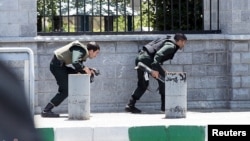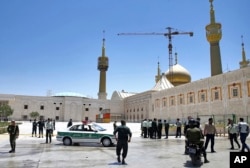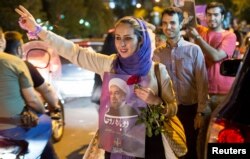Iranian reformists and opposition groups are worried that hard-liners may use this week’s Islamic State-claimed twin terror attacks to press leadership in Tehran to crack down on social media and renege on election promises of freedoms and reforms.
IS claimed responsibility for Wednesday’s attacks on parliament and the mausoleum of the Islamic Republic's founder, Ayatollah Khomeini, killing at least 17 people and injuring several others.
Iran had dismissed IS threats since 2007, including a March video in which the group promised to conquer the country soon.
Publicly, supporters of the regime promoted the supposition that IS’s extreme Sunni-based theology has no support in largely Shi’ite Iran. But the systematic oppression of Sunni minority Iranians has led a number of Iranian millennials to join the extremist group, analysts say.
In the days after the attacks, Iranian authorities arrested more than 40 suspects of Iranian origin linked to IS, and said the main attackers were Iranians who had fought for IS in Syria and Iraq.
IS sympathizers
Some experts estimates the numbers of active Iranian IS sympathizers are close to 1,000. The attack rippled through the Iranian fabric and shattered the regime’s veneer of security and control, analysts say.
“The attack will be of concern to the Iranian authorities, not least because of the tragic loss of life, but also the humiliation of IS being able to strike in the Islamic Republic’s capital, and symbolically against the republic’s founder and first leader,” terror analyst Bruce Hoffman said in an interview with the Council on Foreign Relations. “IS has brought the war home to Iran in a way that hasn’t occurred since the Iran-Iraq War in the 1980s.”
In his first reaction to the attacks, Iranian supreme leader Ayatollah Khamenei launched a wave of indirect criticism at newly re-elected President Hassan Rouhani, suggesting that his administration has allowed dissidents to recruit and organize through social media, particularly the popular Telegram messaging application.
“The central decision-making social and cultural organs are dysfunctional,” Khamenei, who has disagreed with Rouhani on several issues related to domestic reforms and opening to the West, said in a speech to pro-regime students.
Social freedoms
Some say they believe Khamenei’s statement could be interpreted as more pressure on social freedoms promised by Rouhani during the election campaign.
“It’s obvious that security measures are going to be tightened in some particular areas,” said Meisam Karimi, a Tehran-based journalist and blogger. “But the most important thing is that the hardliners will push for more internet and social media blockage and will use it as a vehicle to avenge their defeat in the recent election.”
Rouhani’s re-election last month was largely a result of social media mobilization by prominent intellectuals, actors and social media figures who waged social media campaigns to urge people to vote for him, analysts say.
“They long pushed to have social media and particularly the Telegram app to be banned or controlled and couldn’t reach their goal,” Karimi said of the hard-liners. “Now with this terrorist attack, which was orchestrated by Telegram app, they find the excuse they looked for.”
Hours after the terror spree in Tehran, IS-affiliated Amaq social media released a video allegedly showing the attackers storming a parliament office, shooting at staff and shouting IS slogans in Arabic.
Days earlier, Afghan security forces arrested an Iranian national fighting with the IS in eastern Nangahar province who confessed to being recruited via Telegram. With approximately 20 million users, Telegram is the most widely used messaging app in Iran.
The Iranian intelligence have publicly claimed quick success after arrested agents and cells linked to IS. However, the timing of this incident could be cited as evidence of Rouhani’s ineffective security procedures in his first term despite his experience in such affairs, analysts say.
“Rouhani has replaced some of the high-ranking authorities at the intelligence ministry in the past years,” said Mahan Abedin a U.K.-based author and expert on Islamic movements and ideologies.
Shahriar Zarshenas, a conservative security theorist, warned Rouhani of a looming security crisis a few months before the re-election, according to Iranian media reports.
“It is obvious that the security system is suffering from sort of indecency when some IS agents can reach to the fourth floor of the parliament building,” said Houchang Hassan Yari, a scholar at the Royal Military College of Canada.
Security concern
A number of security agents have complained that Rouhani’s appeasement policy in the largely Kurdish Sunni region in western and southern Iran was hurting the country’s security.
A leaked report from Iran’s intelligence ministry in 2014 said activities linked to IS and the number of Salafi activists who disseminate jihadi ideologies both increased dramatically during Rouhani’s first term.
“There are numbers of Iranian Sunni Kurds who have imbibed the Salafi ideas and internalize it as a measure to defend their dignity and as a way to regain the rights they believe have been stolen from them,” said Babak Taghvaee, a military expert based in Malta.
The March video issued by IS alleged that more than 18,000 Iranian Sunnis have been executed since the 1979 Islamic Revolution. One speaker urged Sunnis to join IS "to defend their dignity and regain the pride taken away by Iranian Shia authorities."
Iran’s involvement in propping up the Syrian and Iraqi regimes trying to gain control of territory taken from IS also has rankled Sunnis, analysts say.
“The resultant anger among a large population of Sunnis has had many manifestations in Iraq, and it was inevitable that it would have the same impact on many aggrieved Sunnis who perceive Iran to be at the center of a conspiracy against Sunnis in the region,” said Rashad Ali, senior fellow at the Institute for Strategic Dialogue. "This is at the root of this attack.”










